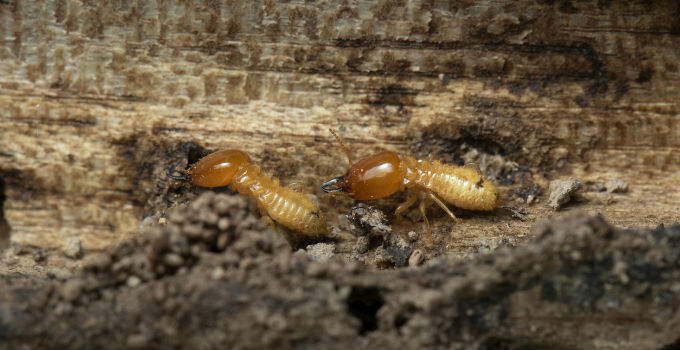There are several types of termites that cause damage in Gilbert, AZ. Termites can cause significant harm to structures made from wood which can include your home or business. Termites are a common occurrence in nature, and are constantly in search of additional food sources. Worker termites travel underground looking for fallen trees, decaying wood, plant debris, and other cellulose materials to consume and bring back to the colony. It is not uncommon to find termites in mulch or a nearby wood pile around your home. Improper moisture control, leaf litter, and direct wood-to-soil contact are all prime conditions that can promote termite activity on your property, often times within close proximity to your home. While foraging, worker termites will enter cracks in the foundation of your home, ultimately leading them to the wood within the structure.
What are subterranean termites?
In Arizona, subterranean termites are the most common species, and they cause the biggest problem for homeowners. Each type of termite thrives in a different kind of habitat. Subterranean termites, as their name suggests, live underground. This doesn’t stop them from traveling into your home. They create mud tubes, are an elaborate network of tunnels used for protected navigation. These pathways are sometimes visible when termites construct them in basements.
During swarming, these termites grow wings and branch off from their colony to form new colonies. These colonies can grow and present problems for homeowners who do not deal with the issue at the first signs of infestation.
What are drywood termites?
Unlike subterranean termites, drywood termites live directly in wood and not in the ground. They are not as common in Arizona, but they can cause significant damage because they are more difficult to spot.
Drywood termites bore into wood, and the most common, but still hard to find, evidence of their presence is tiny holes and piles of wood-colored droppings called “frass.” If you think you have drywood termite damage, tap on the possibly affected spot. If it sounds hollow, drywood termites could be causing damage. During the summer, these termites swarm, so you will see them with wings, or you will see heaps of wings outside of the holes. Although their wings are small, the piles are easily visible.
Other Species of Termites
Dampwood termites thrive in moisture and attack wood that is on or under the ground. They may eat bushes or small trees, using the sap as a means for survival Though they rarely attack houses, they can destroy human-made structures such as fence posts. Another species, desert termites, do not attack homes, but they do eat dead plant matter, making them widely regarded as beneficial to the environment.
How can I tell if I have termites in my home?
Drywood and subterranean termites can cause significant damage. By some estimates, termites cause as much as $6 billion in damage to buildings per year. It’s easy to spot termite activity when you find small piles of wings.
During their swarming season, which is in the springtime or the monsoon season,the reproductive members of a colony have wings and they often fly towards windows and doorways or underneath light sources. Their sole purpose is to find a mate and set up a new colony in or around your home. The fragile wings of termite swarmers fall off after their first and only flight, gathering in small piles that you may find around your home. Another way to identify termite infestations is to find affected wood. Feel for soft spots in your ceiling or floor, warped doors, peeling paint, hollowed wood, or blistering pieces of wood. As previously mentioned, mud tubes are a sure sign of termites.
How to Avoid a Termite Infestation

One way to prevent subterranean termites is to seal all cracks in your foundation that are near the ground. By blocking access points, you are less likely to suffer from termite infestations. You should also remove any wood that may have contact with the soil, which could include porch or deck structures attached to your home,landscaping elements made from wood, and piles of firewood. Unfortunately, preventing termites with 100% success on your own is incredibly difficult.
How can SOS Exterminating get rid of termites at my home?
SOS Exterminating, can not only locate a termite problem, but we can take the necessary steps to eradicate colonies that are currently damaging your home. Active monitoring and elimination services are available through our unique SOS Bait Barrier System. If termites are present on a property, a highly trained SOS Exterminating pest professional uses the Bait Barrier System to eliminate the colony. If a new colony invades, it also is eliminated. This is accomplished by placing bait stations in the soil around the home, which are less disruptive and more effective than traditional methods. By using the SOS Bait Barrier System, we can get rid of termites in an environmentally conscious way. Instead of surrounding your house with diluted chemical solution, our Bait Barrier System strategically uses termite bait and cleverly manipulates natural termite biology and behavior to destroy the termite colony.
Do you suspect that you have termites in your Gilbert, AZ home or business? Give us a call or fill out the form on this page to learn more about our termite control plans and to set up a free, no-obligation termite inspection.
What Kind of Termites are in Gilbert, AZ? Professional Pest Control Services in Gilbert, AZ
Serving Maricopa County | Pima County | Yavapai County | Coconino County | Pinal County

 480-497-1500
480-497-1500 
